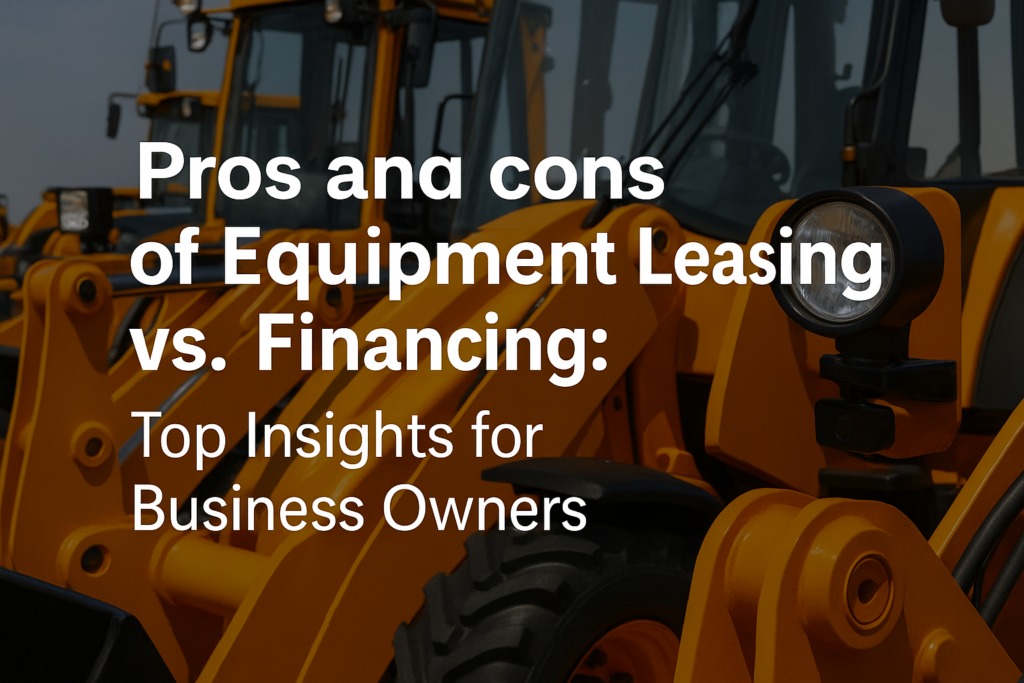Pros and Cons of Equipment Leasing vs. Financing: Top Insights for Business Owners

Understanding Equipment Leasing and Financing
What is Equipment Leasing?
Equipment leasing is a business arrangement where companies rent equipment for a set period. Unlike purchasing, leasing doesn’t require large upfront payments. This makes it ideal for startups or small businesses that want to preserve capital or access essential tools without heavy investment.
Leases can include maintenance services and upgrade options, which means businesses avoid the burden of obsolescence. It’s an excellent choice for industries where technology or standards evolve quickly.
What is Equipment Financing?
Equipment financing allows businesses to buy equipment through loans or credit agreements. Once the loan is repaid, the business owns the equipment outright. This method is better suited for companies that plan to use the asset long-term and want to build equity.
With the emergence of equipment financing platforms, it’s easier than ever for startups and small businesses to apply for loans, compare options, and secure funding digitally.
Key Differences Between Leasing and Financing
Ownership Structure
- Leasing: You rent the equipment and return it at lease end unless there’s a buyout clause.
- Financing: You own the equipment after the loan term.
Cost Implications Over Time
- Leasing = Lower upfront costs but no ownership.
- Financing = Higher initial investment, but eventual ownership and potential ROI.
Flexibility and Contract Terms
Leasing provides greater flexibility in terms of upgrades and maintenance, while financing suits companies looking for long-term stability and fixed costs.
Advantages of Equipment Leasing
Lower Upfront Costs
Equipment leasing is ideal for businesses that want to manage their cash flow. It requires minimal upfront investment, making it suitable for a startup equipment financing plan where initial capital is limited.
Maintenance and Upgrades Included
Some leases include built-in service packages or allow for periodic upgrades, keeping your operations efficient and up-to-date.
Tax Benefits of Leasing
Wondering, “Are equipment lease payments tax deductible?” Absolutely. These payments are often fully deductible as business expenses, reducing your taxable income and improving your bottom line.
Easier Approval for Startups
For an equipment financing startup or a business with limited credit history, leasing offers easy equipment financing options. Approval processes are generally less strict, making it a viable path for early-stage businesses.
Disadvantages of Equipment Leasing
No Ownership Equity
At the end of the lease, the business doesn’t own the equipment unless a purchase option is exercised.
Higher Long-Term Costs
You may pay more over time than if you had purchased the equipment outright due to interest and leasing fees.
Early Termination Penalties
Exiting a lease early can lead to substantial penalties, limiting flexibility if your business needs shift.
Advantages of Equipment Financing
Eventual Ownership
Once the loan is repaid, the equipment belongs to your company. This adds to your business’s assets and can even be used as collateral in the future.
Fixed Monthly Payments
Financing agreements usually offer predictable payment structures, which help in long-term financial planning and budgeting.
Equipment as a Business Asset
Financed equipment contributes to the business’s equity. It can be depreciated or resold, creating more value over time.
Potential Tax Deductions
Purchasing equipment via financing often allows you to use IRS Section 179 deductions and claim depreciation benefits, providing substantial tax relief.
Disadvantages of Equipment Financing
Higher Upfront Costs
Financing often involves a significant down payment and closing costs, which might be challenging for new ventures.
Responsibility for Maintenance and Repairs
The burden of upkeep and repairs lies entirely with the owner, adding to total cost of ownership.
Technology Obsolescence Risk
When you own the equipment, you run the risk of it becoming outdated quickly, especially in tech-heavy industries.
When to Choose Equipment Leasing
- Short-term projects
- Frequent need for equipment upgrades
- Limited capital or credit history
When to Choose Equipment Financing
- Long-term or permanent equipment needs
- Strong cash flow or funding access
- Desire to build equity through asset ownership
Industry-Specific Considerations
Construction and Heavy Equipment
Leasing is popular for short-term projects or specialty machinery. Financing is preferred when the equipment is used consistently over years.
IT and Tech Industry
Given the pace of innovation, leasing helps companies keep up with the latest tools and platforms without becoming outdated.
Medical Equipment
Hospitals and clinics often opt for leasing to ensure compliance with the latest safety and diagnostic standards.
Impact on Financial Statements and Credit
Balance Sheet Impact
- Leased assets may be considered off-balance-sheet, which can improve certain financial ratios.
- Financed equipment is listed as both an asset and a liability.
Credit Score Considerations
Financing may require better credit scores, while leasing options are typically more accessible for companies with modest credit profiles.
Tax Considerations for Leasing and Financing
Section 179 Deductions
Equipment bought via financing may qualify for significant tax deductions under Section 179, allowing full deduction in the year of purchase.
Operating Expense Deductions
Lease payments, being operational expenses, are usually fully tax deductible, making them attractive from a tax planning perspective.
Real-Life Case Studies
Leasing Success Story
A tech equipment financing startup needed high-end development servers. Instead of incurring heavy capital expense, they leased through a leading equipment financing platform. This strategy enabled rapid growth and easy tech upgrades.
Financing Success Story
A construction company financed two excavators through a new equipment financing platform launch, taking advantage of AI-enhanced risk analysis and faster approval. Ownership allowed them to use these assets for multiple long-term projects.
Questions to Ask Before Choosing
- What is the expected lifespan of the equipment?
- Do I need flexibility or long-term stability?
- What’s the total cost of ownership including interest and tax?
How to Choose the Right Option for Your Business
Seek advice from a certified financial planner or accountant. Consider using an online equipment financing platform for instant comparisons, transparent fees, and simplified applications.
Common Mistakes to Avoid
- Not comparing total costs between leasing and financing.
- Overlooking tax implications and benefits.
- Ignoring contract fine print and cancellation clauses.
Frequently Asked Questions (FAQs)
1. Which is better for a startup, leasing or financing?
Leasing is usually better for startups due to lower upfront costs and easy equipment financing approval.
2. Are equipment lease payments tax deductible?
Yes, lease payments are typically fully deductible as business operating expenses.
3. Can I finance equipment with bad credit?
It’s harder, but platforms now offer tailored startup equipment financing options even for lower credit scores.
4. How does equipment financing help build equity?
Financing results in eventual ownership, allowing the equipment to be used as an asset or collateral.
5. Is leasing better for tech equipment?
Yes, due to the frequent need for upgrades and fast-paced obsolescence in technology.
6. What is an equipment financing platform launch?
It refers to a new digital service that simplifies access to financing or leasing through online tools and automated approvals.
Conclusion
Final Thoughts on Leasing vs. Financing
Choosing between equipment leasing and financing depends on your company’s current needs, future goals, and financial health. Leasing offers flexibility and ease of access, especially for startups, while financing allows for ownership and long-term savings.
With tools like an equipment financing platform, businesses can now explore options quickly, make informed decisions, and secure vital tools that drive growth. Whether you’re just starting out or scaling up, choose the path that aligns with your vision and budget.




No comment